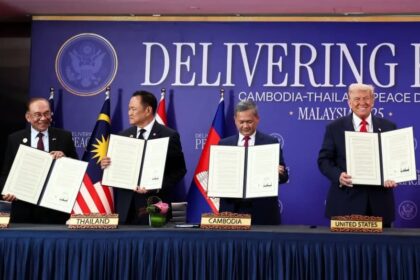A turning point for yuan bonds issued by foreign borrowers
China’s panda bond market is moving from niche to mainstream as more overseas borrowers tap local investors for funding in Chinese currency. Panda bonds are issued in China by entities based outside the mainland, and they give foreign companies, financial institutions, and governments access to the country’s deep pool of savings. Outstanding panda bonds recently reached about 389 billion yuan, a new high that has surpassed the amount outstanding for samurai bonds, which are yen bonds sold by foreign issuers in Japan. The surge reflects cheaper funding available in China compared with dollar or euro markets, as well as Beijing’s goal to expand the global use of the renminbi (RMB) and strengthen ties with partner countries.
- A turning point for yuan bonds issued by foreign borrowers
- What exactly are panda bonds
- Why the cost advantage has widened
- From ADB to AIIB to Wall Street issuers
- A channel for Belt and Road relationships
- The Russia question and sanctions risk
- Can panda bonds aid debt relief and restructuring
- Green finance is moving onshore in China
- Risks investors and issuers need to weigh
- Where the market could go next
- Key Points
For policymakers in Beijing, the appeal is clear. Every new panda bond issued helps bring more global capital and more international names into China’s onshore market. It also encourages foreign borrowers and investors to become familiar with China’s legal and trading infrastructure, which supports the long running effort to internationalize the RMB. For many emerging market governments and companies, panda bonds can lower borrowing costs, diversify funding sources, and reduce exposure to swings in the US dollar.
The investors backing this boom have multiplied. More than 1,100 institutions from over 70 countries were active in China’s bond market by late 2024, and foreign holdings of Chinese bonds reached about 4.4 trillion yuan. Regulators have also made it easier to issue, trade, and hedge. These changes have drawn a broader mix of borrowers, from development banks to global corporate names, and have opened the door to sovereigns across the Belt and Road network that want local currency financing.
What exactly are panda bonds
Panda bonds are RMB denominated bonds issued within China’s domestic market by non mainland entities. Issuers can be sovereigns, government agencies, multilaterals, financial institutions, or corporates that are incorporated outside mainland China. They are listed and cleared in China’s onshore system and sold primarily to onshore investors, although offshore participation is rising.
How panda bonds compare with other Asian local currency options
Investors sometimes confuse panda bonds with Dim Sum and samurai bonds. Dim Sum bonds are also RMB denominated, but they are issued offshore, mainly in Hong Kong, and follow different listing and disclosure practices. Samurai bonds are yen denominated instruments issued by foreign entities in Japan. Panda bonds are unique because they are sold onshore in China’s domestic market, which gives issuers direct access to mainland liquidity and investor demand, while also bringing them under Chinese regulations and market conventions.
Why issuers care about the venue
Choosing panda bonds can affect pricing, investor mix, and use of proceeds. Onshore pricing often benefits from China’s lower interest rate environment. The investor base skews toward Chinese banks, insurers, and asset managers, a group that has grown more comfortable with high grade foreign names. Regulatory adjustments in recent years have given issuers more flexibility to use proceeds outside China, subject to approvals, which has made panda bonds far more practical for global treasurers.
Why the cost advantage has widened
Two market forces have favored panda bonds since 2023. First, interest rate divergence has made RMB borrowing cheaper than dollar borrowing for many credits. Second, China streamlined rules on documentation, ratings, accounting, and use of proceeds. Borrowers report faster timetables and more predictable outcomes, while investors can manage rate risk through tools such as Swap Connect, which links the onshore interest rate swap market with overseas participants.
Issuance data tells the story. Panda bond gross issuance hit roughly 155 billion yuan in 2023, then rose again to about 195 billion yuan in 2024. Cumulative panda issuance has climbed past 800 billion yuan. The combination of lower yields in China and a larger, more diverse investor base has pulled in corporates, financials, sovereigns, and multilaterals. Many global firms are also adopting a China for China approach, raising RMB locally to fund their China operations and supply chains and to hedge RMB exposures inside the country.
Investors have followed that trend. Onshore funds value high quality names with attractive spreads relative to top Chinese policy bank benchmarks. Offshore investors, including regional bank treasuries and some central banks, see panda bonds as a way to add RMB assets without navigating a full onshore account setup for each trade. The steady growth in cross border trading links has also helped the market mature in settlement and custody.
From ADB to AIIB to Wall Street issuers
Development institutions pioneered panda bonds in the mid 2000s, led by the Asian Development Bank and the International Finance Corporation. That early phase set templates for documentation and disclosure. The issuer base is now far broader. Sovereigns in Asia and the Middle East have tested the market, multinational banks have joined, and supranationals continue to return with repeat deals.
A recent deal by the Asian Infrastructure Investment Bank (AIIB) showed how deep demand has become. AIIB sold a two year panda bond of 2 billion yuan with a coupon near 1.64 percent, priced at a spread of roughly 7 basis points over China Development Bank bonds. Orders reached about 6.4 billion yuan, an oversubscription of about 3.2 times. More than 30 investor accounts participated, including a notable share of offshore banks and official institutions, which indicates that panda bonds are attracting new classes of buyers alongside Chinese banks and insurers. The distribution skewed toward bank treasuries, with smaller slices to central banks and asset managers. AIIB presented the outcome as its tightest onshore spread in recent years, a signal of growing investor comfort with top tier international credits onshore. For official details on that transaction, readers can consult the AIIB website at aiib.org.
Corporate interest is also rising. In one milestone, a major US financial institution issued a five year panda bond of 2 billion yuan at a yield near 1.98 percent, only slightly above the average for comparable onshore corporate paper. That step marked the first panda bond sold by a US company, and it may encourage other global names to explore similar issues. Lower coupons, a deep onshore investor pool, and a desire to match onshore RMB assets with RMB revenues are all pushing corporates toward this market.
A channel for Belt and Road relationships
The Belt and Road framework is a key driver of panda bond outreach. China has encouraged partner governments to consider RMB borrowing onshore, especially those facing high dollar interest costs and heavy refinancing calendars. Discussions at recent China Africa forums have highlighted panda bonds as an alternative to expensive Eurobond issuance for countries with elevated risk premiums. For borrowers in Africa and other emerging regions, panda bonds can diversify funding away from a narrow set of lenders and broaden access to private investors in China’s market.
There are practical advantages for issuers and their economies. Panda bond proceeds can be used to fund projects that involve Chinese trade partners, which can reduce currency mismatches when import bills or contractor payments are in RMB. Over time, this can help support the use of RMB in cross border trade. At the same time, panda issuance encourages regulatory familiarity and could pave the way for more local currency swaps and hedges with Chinese counterparties, reducing volatility for public finances.
For China, these bonds support the international role of its currency while limiting the need for direct state bank lending in every project. When private investors and commercial banks buy panda bonds, they share the funding burden, which can improve allocation and pricing discipline. A more active secondary market also helps the price discovery process for sovereign and quasi sovereign credit risk inside China.
The Russia question and sanctions risk
Russia’s experience shows the geopolitical limits of the panda bond push. Since the start of the Ukraine conflict, Russian corporates have struggled to access onshore RMB financing. Chinese banks and securities firms have been cautious about deals that could trigger secondary sanctions. Preparatory work by well known Russian energy and industrial firms has stalled, and since 2022 there has been no successful panda deal from Russian issuers. Even before the conflict, issuance by Russian corporates was rare, with a 2017 deal by a metals producer the main example.
There have been periodic efforts to revive the channel. Russian executives have held talks in China about potential RMB bond offerings linked to energy cooperation, including pipeline projects discussed at high level meetings. Those conversations have not yet produced onshore issuance, reflecting the balance Beijing must strike between its strategic partnership with Moscow and its broader trading and financial interests with other major economies. The episode underscores a central reality of panda bonds. Politics and sanctions risk can override purely financial logic, regardless of yield advantages that might be available to an issuer.
Can panda bonds aid debt relief and restructuring
Development finance experts have begun to explore panda bonds as a component in debt workouts for distressed sovereigns. One proposal, sometimes called the Shanghai model, adapts ideas from the 1980s Brady Plan. The concept is to swap bank loans or other bilateral claims into new tradable sovereign bonds, potentially issued onshore in RMB with credit enhancements or partial guarantees from multilateral institutions. If designed well, such instruments could boost liquidity, attract a broader investor base, and reduce the strain on individual official creditors while giving borrowers time to restore growth and fiscal balance.
Key ingredients would include transparent structures, robust disclosure, and credible third party support, for example guarantees or political risk insurance. China’s onshore market now has the technical capacity to handle such transactions. Programs like Swap Connect allow hedging of interest rate exposure, and recent reforms have simplified issuance and made it easier to deploy proceeds for projects outside China. While high risk countries may still face elevated coupons, credit enhancement can help reduce the all in cost and unlock investor demand.
There is also a strategic benefit for China. If more distressed borrowers refinance part of their obligations into tradable bonds held by private investors, the concentration of credit risk at Chinese state lenders could fall. Private participation can help price risk more efficiently and encourage stronger project selection and monitoring standards across future lending.
Green finance is moving onshore in China
China’s green finance ecosystem has expanded quickly and is increasingly aligned with international standards. The country pioneered a green credit system a decade ago, and by September 2024 the outstanding stock of green loans reached roughly 35.75 trillion yuan. On the bond side, China introduced a green taxonomy in 2016 and later worked with European authorities on the Common Ground Taxonomy to improve comparability across markets. Between 2020 and 2024, a large share of green issuance in ASEAN plus three economies came from China, and in 2024 alone the country issued close to 700 billion yuan in green bonds.
Panda bonds are becoming part of this story. Foreign borrowers can issue green panda bonds that follow Chinese or Common Ground standards, channeling RMB savings into renewable energy, clean transport, water infrastructure, and transition finance for heavy industry. Policy guidance for overseas green investment by Chinese institutions, including traffic light systems that flag fossil fuels as red and solar as green, is shaping how projects are screened across the Belt and Road footprint. While China continues to build new domestic coal capacity, it also leads the world in new renewable installations and exports of solar and battery equipment. Panda bonds linked to credible green frameworks can help fund that shift for partner countries and corporates operating in Asia.
Risks investors and issuers need to weigh
Panda bonds are not risk free. Currency risk is the most visible. Issuers that do not earn RMB revenues need hedges, and investors not benchmarked to RMB face translation risk. Liquidity can be thinner than in global dollar markets, especially for smaller deals or first time issuers. Market making and secondary trading have improved but remain less active than in offshore benchmarks.
Policy and regulatory risk also matters. China’s capital account is managed, and approvals still govern many cross border flows. Rules on data, disclosure, and market access can evolve, sometimes quickly. Foreign firms face a complex legal environment that includes cybersecurity and data localization requirements and heightened compliance expectations. The investment climate remains attractive in scale, but foreign participants often cite limited transparency and case by case enforcement as ongoing concerns. Readers can review the official investment climate overview published by the US government at state.gov for more on these topics.
Geopolitics is a final, critical factor. Sanctions risk can shut an issuer out of the market, even if there is investor appetite and compelling pricing. Changes in relations between China and a borrower’s home government can also affect approvals, distribution, or settlement. Prudent issuers build contingency plans for access to multiple markets, and prudent investors price these risks into their portfolios.
Where the market could go next
Several forces point to steady growth for panda bonds. Onshore yields remain attractive for high grade borrowers compared with US dollar or euro markets. Regulatory pathways are clearer than they were a few years ago, and cross border trading and hedging links continue to deepen. More sovereigns from Belt and Road partner countries are exploring inaugural issues, including green and sustainability themed bonds that match local investment needs. Repeat issuance by multilaterals, frequent corporate borrowers, and top tier global banks is likely to build benchmarks and support a more active secondary market.
There are constraints. Capital controls limit the speed of RMB internationalization. Some foreign investors remain cautious about legal and accounting differences, and corporate treasuries weigh the effort of obtaining approvals against the savings in coupons. The market’s geopolitical sensitivity is a persistent risk, as the experience of Russian corporates shows. Even with those caveats, the overall direction is toward greater depth and diversity as China’s onshore market opens and as more global names seek RMB exposure.
The next phase will be shaped by a few practical milestones. More US and European corporates testing three to five year tenors would broaden the curve. Sovereign issues by a handful of mid sized emerging economies would create comparables and draw fund mandates that target local currency exposure across Asia. Greater use of green frameworks would integrate panda bonds into the region’s climate finance toolkit. Continued progress on trading and hedging links would address operational concerns for global investors. If these pieces fall into place, panda bonds will become a regular feature of global funding programs for issuers across sectors.
Key Points
- Panda bonds are RMB bonds issued onshore in China by non mainland entities, with outstanding volume near 389 billion yuan.
- Issuance accelerated in 2023 and 2024 amid lower RMB rates and streamlined rules, with gross volumes around 155 billion yuan and 195 billion yuan respectively.
- Cumulative panda bond issuance has surpassed 800 billion yuan, and foreign holdings of Chinese bonds reached about 4.4 trillion yuan by late 2024.
- AIIB’s recent 2 billion yuan panda bond drew 3.2 times orders and priced at roughly 7 basis points over a top policy bank benchmark.
- A major US bank sold the first panda bond by a US company, a five year 2 billion yuan deal around a 1.98 percent yield.
- Beijing encourages partner countries, including in Africa, to use panda bonds to lower costs versus Eurobonds and to deepen RMB use in trade.
- Sanctions fears have kept Russian corporates out of the market since 2022, highlighting geopolitical limits to panda issuance.
- Panda bonds could support debt restructuring through onshore instruments with credit enhancements under models discussed by development finance experts.
- Green panda bonds fit China’s growing green finance system, including taxonomies aligned with international standards.
- Key risks include currency exposure, liquidity, regulatory complexity, capital controls, and geopolitical constraints on eligible issuers.












